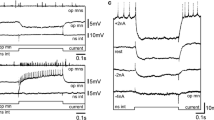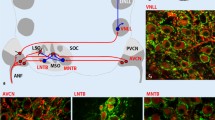Abstract
Electrophysiological and morphological studies of a monosynaptic connection are performed on specimens of the isolated CNS of the snailAchatina fulica, using the standard techniques of intracellular leading-off and neuron stimulation and intracellular pressure injection of cobalt chloride. The presence of a monosynaptic connection between two identified neurons is demonstrated both in the physiological experiment and by means of the intracellular dye.
Similar content being viewed by others
Literature cited
P. M. Balaban and E. G. Litvinov, “Command neurons of the defensive unconditioned reflex in snails,” Zh. Vyssh. Nerv. Deyat.,27, No. 3, 538 (1977).
L. A. Berezhnaya, “Structural organization of the processes of an identified giant neuron in the snail,” Zh. Vyssh. Nerv. Deyat.,36, No. 6, 1125 (1986).
N. G. Kolosov and A. Ya. Khabarova, Structural Organization of Autonomic Ganglia [in Russian], Nauka, Leningrad (1987).
V. I. Koshev, “Polymorphism of Dogel's type II cells and their distribution characteristics along the cat digestive track,” in: Intraganglionic Interneuronal Connections and Nerve Tissue Interrelations [in Russian], Nauka, Leningrad (1975), p. 83.
D. B. Logunov and P. M. Balaban, “A monosynaptic connection between identified snail neurons,” Dokl. Akad. Nauk SSSR,240, No. 1, 237 (1978).
V. G. Lukashin, “Neuronal interrelations in the intramural ganglia,” in: Intraganglionic Interneuronal Connections and Nerve Tissue Interrelations [in Russian], Nauka, Leningrad (1975), p. 47.
O. A. Maksimova and P. M. Balaban, Neuronal Mechanisms of Behavioral Plasticity [in Russian], Nauka, Moscow (1983).
S. A. Sarkisov, Essays on the Structure and Function of the Brain [in Russian], Meditsina, Moscow (1964).
E. R. Kandel, Cellular Basis of Behavior: An Introduction to Behavioral Neurobiology, Freeman (1976).
C. Lazar, “Application of cobalt-filling technique to show retinal projections in the frog,” Neurosci,3, No. 8, 725 (1978).
D. P. Munos, P. A. Pawson, and R. Chase, “Symmetrical giant neurones in asymmetrical ganglia. Implications for evolution of the nervous system in pulmonate molluscs,” J. Exp. Biol.,107, 147 (1983).
Author information
Authors and Affiliations
Additional information
Translated from Zhurnal Vysshei Nervnoi Deyatel'nosti imeni I. P. Pavlova, Vol. 39, No. 2, pp. 329–333, March–April, 1989.
Rights and permissions
About this article
Cite this article
Berezhnaya, L.A., Balaban, P.M. A monosynaptic connection between identified snail neurons. Neurosci Behav Physiol 20, 174–177 (1990). https://doi.org/10.1007/BF01268137
Received:
Issue Date:
DOI: https://doi.org/10.1007/BF01268137




